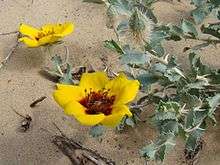Rosa persica
Rosa persica is an anomalous species of rose that at one time was placed in a separate genus Hulthemia. It is native to deserts and steppes from Iran and Afghanistan in the south, through Central Asia, to western Siberia in the north.[3] Its distinctive characteristics include a simple leaf without stipules (most rose leaves are pinnate with 3 to 7 leaflets, and have stipules), and a distinctive flower with a darker coloured central zone. In its natural habitat it is a deep-rooted weed that suckers – growing in Iranian fields for example, where it is collected for fuel once the grain crop has been harvested[4] – but it is difficult to grow in gardens and rarely cultivated.
| Rosa persica | |
|---|---|
 | |
| Scientific classification | |
| Kingdom: | Plantae |
| Clade: | Tracheophytes |
| Clade: | Angiosperms |
| Clade: | Eudicots |
| Clade: | Rosids |
| Order: | Rosales |
| Family: | Rosaceae |
| Genus: | Rosa |
| Species: | R. persica |
| Binomial name | |
| Rosa persica | |
| Synonyms [1][2] | |
Rosa berberifolia is sometimes considered to be variety of this species, as R. persica var. berberifolia.
Hybrids
Rosa persica can hybridise with other rose species,[5] and these hybrids have in the past been known as the hybrid genus ×Hulthemosa. One of the few ×Hulthemosa cultivars commercially available is 'Alissar, Princess of Phoenicia' (also known as 'Harsidon').[6] In the spring of 2012, rose hybridizer Jim Sproul released a new line of Hulthemia hybrids known as Eyeconics, the culmination of fifteen years of effort on his part.[7]
The yellow colour in cultivated roses is not generally derived from this species, but from other yellow-flowered wild roses.
Similar species
Other species of yellow-flowered roses include:[3]
- R. banksiae
- R. ecae (syn. R. xanthina var. ecae)
- R. foetida (syn.: R. lutea)
- R. gigantea (syn. R. × odorata var. gigantea)
- R. hemisphaerica (syn. R. sulphurea)
- R. kokanica
- R. primula
- R. xanthina
See also
References
- USDA Germplasm Resources Information Network entry for Rosa persica
- USDA Germplasm Resources Information Network entry for Hulthemia
- Phillips, R.; Rix, M. 1988. The Random House Book of Roses. Random House, New York.
- Phillips R. and Rix, M., Roses, Macmillan, 1994, p19
- Jack Harkness "Breeding with Hulthemia persica (Rosa persica)", American Rose Annual 1977
- HelpMeFind.com listing for rose cultivar 'Alissar, Princess of Phoenicia'
- Hunt, Lynn. "A Closer Look at the New Eyeconic Roses". The Christian Science Monitor. Retrieved March 21, 2013.
External links
| Wikimedia Commons has media related to Rosa persica. |